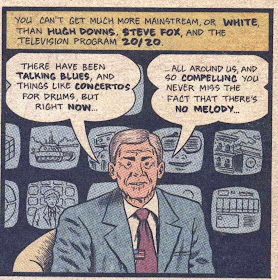Hip Hop Family Tree No. 1
by Ed Piskor
Fantagraphics Books, 2013
Ed Piskor (b. 1982) is a Pittsburg-based cartoonist who did several graphic novels, including American Splendor: Our Movie Year and The Beats: A Graphic History, as well as a series titled Phreak, about the first generation of phone and PC hackers.
Piskor, who was only an infant when hip hop emerged in the pop culture, produced a regular web comic for the BoingBoing website titled 'Hip Hop Family Tree'. The webcomic was an intricate recounting of the early history of rap, from its beginnings in the Bronx in the mid-70s, up to the early 80s.
In 2013 Fantagraphics Books released the compilation of the first set of Family Tree episodes, 'Hip Hop Family Tree No. 1 (1975 - 1981)'.
Volume 2, 'Hip Hop Family Tree No. 2 (1981 - 1983), which presumably includes content currently running at BoingBoing, is scheduled for release in September, 2014.
At 13 x 9.2 inches in size, HHFT: No 1 is designed to mimic the dimensions of the oversize Marvel Treasury 'giant size' comics of the 1970s. Its paper coloration is also designed to mimic the tone and fabric of the cheap paper used in those comics, appropriately aged.
The narrative commences in 1975, with D. J. Kool Herc using his turntable skills to wow the crowds at dance parties in the crumbling neighborhoods of the Bronx. Piskor then moves through the ensuing years of the emergence and convergence of rap, gang culture, break dancing, graffiti, and technology.
All of the Old Scholl Hip Hop stars are represented, including Grandmaster Flash, Kurtis Blow, the Sugar Hill Gang, Russell Simmons (depicted here with a off-kilter eyeball and pronounced lisp), and the Furious Five: Melle Mel, Cowboy, Raheim, Mr Ness, Kid Creole.
But there is also a host of other rappers, street characters, producers, and managers who I was never aware of, and they are here, too: Spoony Gee (so-called because he never ate using utensils other than a spoon !), Spyder D, the Aleems, 'Busy Bee' Starski, 'Lovebug' Starksi, Eddie Cheeba, and the Funky Four Plus One, among others.
Along the way, the seeping of hip hop into the larger music culture is recounted, as Debby Harry and Blondie, along with the Clash, tune into the Bronx music scene.
All sort of little asides and tidbits are disclosed in HHFT: No. 1, and that kept me turning the pages:
Piskor devotes several pages to the epic 1981 battle between 'Busy Bee' Starski and Kool Moe Dee at the Harlem World Christmas Rapper Convention.......Kool Moe Dee wiped the floor.
The book concludes with 1981, when Blondie's song 'Rapture' intorduced rap to the larger, white audience, and mainstream media programs - like the 1981 airing of an episode of the ABC newsmagazine 20/20 - began to deovte attention to the genre.
I can't say I've ever been a fan of the indie comics scene - I have always considered the work of Dan Clowes, Jim Woodring, the Hernandez Brothers, Adrian Tomine, Harvey Pekar, Peter Bagge, etc., etc. to be over-hyped, and lacking in real artistry.
That said, Piskor does effective job with HHFT: No. 1. His decision to use a 'cartoony' drawing style, along with a subdued color scheme, gives the book's graphics a 'vintage' look and feel that meshes well with its subject matter.
If you're over 40, then leafing through the pages of HHFT: No. 1 is sure to evoke at least some degree of nostalgia, for things from that era in pop culture that you may not have thought about for a long, long time - such as buying a 'boombox', a Kangol cap, an adidas tracksuit, or a milk crate - to store, and transport, all your records.













No comments:
Post a Comment